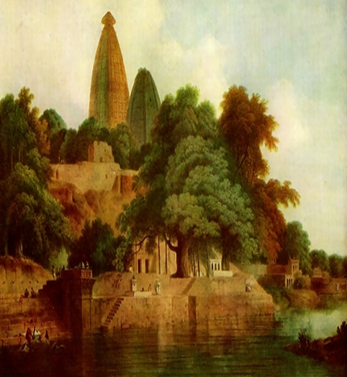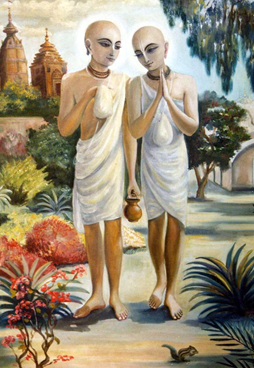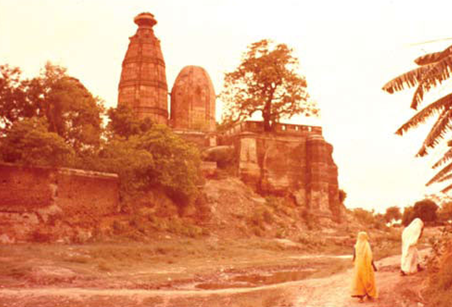

On the order of Lord Chaitanya, Sanatana goswami travelled from Puri to Vrindavan. Traveling once again through the dense Jharikhanda forest (this time with the notes kept by Balabhadra Bhattacharya, who documented the exact path taken by Shri Chaitanya), and then through Benares and Prayag, Sanatana came to Vrindavan.
When he arrived, there were still no temples. What was once the city of Krishna’s youth was then lying vacant like an open field. The very first temple in Vrindavan—Madan Mohan temple—would be established by Sanatana Goswami. His efforts set a precedent and other temples were gradually constructed. Likewise, later the Govinda Deity was established by Rupa Goswami, the Madan-Mohan Deity is said to have originated with Vajranabha, Krishna’s great grandson. To protect these Deities during the violent Muslim invasions, they were buried and, by the time of the Goswamis, were lost or forgotten. The reclamation of these Deities was part of the mandate given to the Goswamis by Shri Chaitanya.
The story behind the discovery of Madan-Mohan is particularly fascinating. It seems that Sanatanaa had a dream in which a beautiful Deity of Krishna was being worshiped by a humble priest from the city of Mathura. Sanatanaa thought that if he could worship that particular Deity in a grand way, it would attract many people to Krishna consciousness. But in the dream, at least, the Deity belonged to this humble brahmana, and Sanatana could not convince him to give up his Deity of Krishna. Without resolving this dilemma, the dream ended.
The next day, however, Sanatan went out to beg alms, as was his custom, and he came to the home of a poor brahmana named Purushottam Chaube. Upon entering his home, Sanatan saw that the events of his previous night’s dream were in fact a reality. Sanatan gazed upon the beautiful form of Madan-Mohan, the same Deity who appeared in his dream. He knew that this Deity was meant to be worshiped in a grand way, for everyone to see.
Nonetheless, just as in Sanatan’s dream, the priest at first refused to relinquish his Deity. But later that night, Madan-Mohan Himself came to the priest in a dream and insisted that he reconsider. Complying with the wishes of Madan-Mohan, the priest entrusted his Deity to Sanatan Goswami. The next day, Sanatan carried the Deity to the opposite side of Vrindavan and established the worship of Madan-Mohan in a little hut. The magnificent temple that was soon to be constructed for the Deity was erected where that little hut once stood.
The construction of the temple can be traced to a wealthy salt merchant named Krishnadas Kapoor who one day was delivering his goods by boat to a market in Agra. When the boat became grounded on a sandbar just opposite Sanatana’s hut, Kapoor began to pray for the help of God. Seeing Kapoor’s despair, Sanatana invited him to worship Madan-Mohan, and while he was praying before the Deity, the boat floated clear. Kapoor was then able to complete his business and, profiting large sums of money as a result, the wealthy merchant felt indebted to Madan-Mohan. Thus he agreed to finance the building of Madan-Mohan’s temple. The imposing edifice that exists today was completed sometime in the 1580s.

After the worship of Madan-Mohan was firmly established, various Deities and their worship were introduced all over the holy land. Govindadev, Radha-Raman, Gopinath, Jugal-Kishor, Banke-Bihari, Radha-Ballabha, Radha-Shyamasundar, Radha-Gokulananda, Radha-Damodar, and the Krishna-Balaram Deities (established in the 1970s by the International Society for Krishna Consciousness, or ISKCON) are the prominent Deities of Vrindavan. But Sanatan Goswami’s Madan-Mohan is, in many ways, the most important.
His Divine Grace A. C. Bhaktivedanta Swami Prabhupada confirms the importance of Madan-Mohan:
Shrila Sanatan Goswami is the ideal spiritual master, for he delivers one the shelter of the lotus feet of Madan-Mohan. Even though one may be unable to travel on the field of Vrindavan due to forgetfulness of his relationship with the Supreme Personality of Godhead, he can get adequate opportunity to stay in Vrindavan and derive all spiritual benefits by the mercy of Sanatan Goswami. This is also the special mercy of Madan-Mohan. In Chaitanya-charitamrita, Krishnadas first offers his obeisances to Madan-Mohan vigraha [Sanatan Goswami’s Deity], the Deity who can help us progress in Krishna consciousness.
Along with Madan-Mohan, Rupa Goswami’s Govindadev Deity and Madhu Pandit’s Gopinath Deity are the life and soul of Chaitanyite Vaishnavas. Madan-Mohan represents sambandha-tattva; Govindadev represents abhideya-tattva; and Gopinath represents prayojana-tattva. As Shrila Prabhupada says:
These three Deities have very specific qualities. Worship of Madan-Mohan is on the platform of reestablishing our forgotten relationship with the Supreme Personality of Godhead. In the beginning of our spiritual life we must worship Madan-Mohan so that He may attract us and nullify our attachment for material sense gratification. This relationship with Madan-Mohan is necessary for neophyte devotees. Then, when one wishes to render service to the Lord with strong attachment, one worships Govinda on the platform of transcendental service. When by the grace of Krishna and the other devotees one reaches perfection in devotional service, he can appreciate Krishna as Gopijanaballabha [Gopinath], the pleasure Deity of the damsels of Vraja.
As the person who established the worship of Madan-Mohan, Sanatan Goswami occupies a special position in the Chaitanyite disciplic succession. He is the representative teacher of sambandha-gyan, or knowledge of our proper devotional relationship with Krishna.
In the year 1670, the fanatic Moghul Emperor Aurangzeb ordered the destruction of all sacred images and temples. At that time, to protect the Lord of their lives, a band of simple villagers moved the Deity of Madan-Mohan from Vrindavan to Jaipur. Soon after the Moghul emperor’s reign, however, when the Deity was again safe, He was moved to Karoli. The King of Karoli, constructed an opulent temple for Madan-Mohan, who remained there ever since.